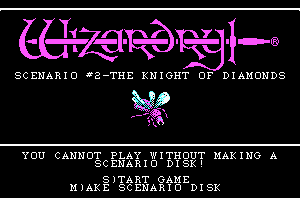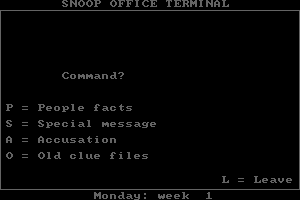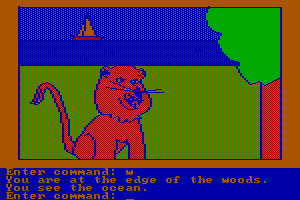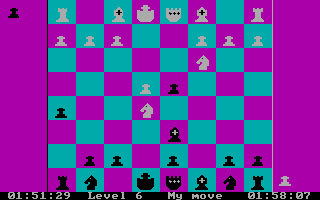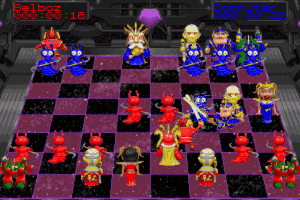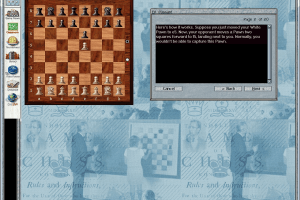Mychess
DOS - 1984
Description of Mychess
Mychess was developed by David Kittinger. Anyone who's not a fan of chess may not know that David is among the best computer chess designers today. After Mychess and its sequel, he developed the popular Chessmaster series for Software Toolworks, and Wchess, one of the most celebrated computer chess programs ever created (and the engine behind Sierra's Power Chess).
So what kind of chess does this 10+ year-old game play? Very challenging one, indeed. The game's hallmark is the strong computer opponent. There are nine difficulty levels, the lowest three of which will not prove too difficult for anyone who has played in some amateur tournaments. But at the six higher levels, Mychess provides a real challenge for seasoned players.
The game lacks mouse support (not surprising, given its age -- PC mouse wasn't even made in 1979!), so you have to move pieces using standard chess notations. This is not cumbersome, though, and the game even offers instant printout of move history on your printer. The graphics are amazingly crisp for 1979 -- the pieces in hi-res black & white look much better than many later games.
Overall, Mychess is a must-have for every chess player. It's not just a real "oldie" with historical value -- it plays a mean game of chess. Two thumbs up!
Review By HOTUD
External links
Captures and Snapshots
Comments and reviews
BenRedic 2020-04-01 0 point
The proto Chessmaster! Mychess was originally developed for and ran under CP/M, hence 1979, at which point MS-DOS did not exist. The version here is basically a 1984 MS-DOS port of the CP/M version, with added graphics. The features and the engine is basically the same.
Mychess was later followed up by Mychess II for a number of 8-bit computers, which basically played the same but had more features. Then it went through a major overhaul and was released as Chessmaster 2000. David Kittinger also went on to produce a number of chess engines for successful computer chess programs and dedicated chess computers.
You can set up a position or set up a game from scratch. You can choose engine strength by limiting number of plies, or by setting a time control. Games can also be printed. There is a rudimentary load/save feature. Game scores can be printed to a printer.
The engine plays a surprisingly competent game of chess, and can certainly measure up against strong early 80s chess programs. Rules of chess are mostly observed, such as castling, promotions and draws, with a few quirks. One quirk is that you are only allowed to promote to a piece that has earlier been taken off the board. So if your queen is still alive, you can't promote to a second queen.
I have also had some issues with the program freezing under MS-DOS. These freezes are reproducable by replaying the exact same games over again: Mychess always freezes at the same moves. Possibly a problem in the MS-DOS port, I have not observed this issue in any of the CP/M versions.
In the following example, Mychess beats White Knight Mk11 for BBC, the accolade winning 1983 precursor to the Colossus chess programs. White Knight thinking at 2 minutes per move, Mychess playing at level 4. White Knight finds itself two pawns down in the endgame, and is duly mated.
[White "White Knight Mk11 BBC"]
[Black "Mychess 1.0 DOS"]
[Result "0-1"]
1.e3
{Apparently, White Knight has no opening book. A very passive move for whites first move.}
1...e5 2.Nf3 e4 3.Nd4 c5 4.Nb5
{Forced to move the knight for the third time in four moves, white quickly finds itself behind in development.}
4...d5 5.N1c3 Nf6 6.Be2 Nc6 7.d4 Be7 8.dxc5 Bxc5 9.O-O a6 10.Na4 Be7 11.Nd4 Qc7 12.Nxc6 Qxc6 13.Nc3 O-O 14.Bd2
{After this somewhat cumbersome opening sequence, white finally finds itself ready to go. But black is better developed.}
14...Bd6 15.Rc1 Re8 16.Re1 Bd7 17.Kh1 Qb6 18.b3 Rac8 19.Kg1 h6 20.Rf1 g6 21.Kh1 Kg7 22.Qe1 Be5 23.Nd1 Ng4 24.Ba5 Qf6 25.f4 $2
{This move weakens the e3 pawn, which immediately becomes a target.}
25...exf3 26.Rxf3 Qg5 27.h4 Qh5 28.Bc3 Bxc3 29.Nxc3 Qe5 30.Rg3 Nxe3
{The goes the e3 pawn.}
31.Bd3 Rxc3 32.Rxe3 Qxe3 33.Qxc3+ d4 34.Qb2 Qf2 35.Rf1 Qxh4+
{Another pawn. Mychess is now two pawns up.}
36.Kg1 Re5 37.Qa3 Bb5 38.Bxb5 Rxb5 39.Qd6 Rf5 40.Rxf5 gxf5 41.Qe5+ Qf6 42.Qd5 b6 43.Kf2 Qh4+ 44.Kf3 Qg4+ 45.Kf2 Qf4+ 46.Qf3 Qd2+ 47.Qe2 Qf4+ 48.Qf3 Qxf3+ 49.Kxf3
{With the last pieces traded off, Mychess is entering an endgame with two pawns up.}
49...h5 50.a3 f6 51.Ke2 Kg6 52.Kd3 f4 53.Kxd4 Kf5 54.c4 h4 55.c5 bxc5+ 56.Kd3 f3 57.Ke3 fxg2 58.Kf2 g1=Q+ 59.Kxg1 h3 60.Kf2 Kg4 61.Kf1 Kg3 62.Kg1 h2+ 63.Kh1
{The white king is stuck, and Mychess wastes no time to go in for the kill.}
63...f5 64.a4 f4 65.b4 f3 66.bxc5 f2
{Ignoring the c pawn, which will not queen in time to make any problems.}
67.c6 f1=R#
{For good measure, underpromotes to a rook, mating.}
0-1
In the following example I play against the CP/M version. The computer makes no glaring blunders, but I am able to build up an attack on the kingside and sacrifice a rook to break through.
[White "BenRedic"]
[Black "Mychess 1.0 CP/M"]
[Result "1-0"]
1.e4 c5 2.Nf3 Nc6 3.Bb5 Nf6 4.Qe2 a6 5.Bxc6 dxc6 6.O-O e6 7.d3
{With the light square bishop off the board, I am putting my pawns on white squares and preparing to attack the weakened pawn structure on the queenside.}
7...Be7 8.Nc3 O-O 9.a4 Bd7 10.Be3 Qb6 11.b3 Qa5 12.Bd2 Qc7 13.Bg5 Qa5 14.Qe1 h6 15.Bd2 Qc7 16.a5
{Locking the queenside, possibly preparing a knight on b6.}
16...e5 17.h3
{Preventing Bg4.}
17...Be6 18.Na4 Nd7 19.Qc1
{Making no progress on the queenside, I turn my sights on the kingside. Planning Na4-c3-e2-g3, clearing away Nf3 and breaking with f4.}
19...Nf6 20.Nc3 h5 21.Ne2 Bd6 22.Ng3 g6 23.Ng5 Bd7 24.Ne2
{Strengthening f4 before the break.}
24...Rad8 25.Qb2
{Pinning e5.}
25...Rfe8 26.f4 Qc8 27.Rf3 Bc7 28.Bc3 Be6 29.Raf1 Nh7 30.Nxe6 Qxe6 31.f5 Qe7 32.Qc1
{Threatens to infiltrate with Qh6.}
32...g5 33.f6 Qf8 34.Rf5 c4 35.bxc4 Qc5+ $2
{Moves the queen away from the defense of the king. Surely mate is unavoidable now?}
36.Kh1 Bxa5 37.Bxa5
( 37.Rxg5+ {I was considering playing this sacrifice right away, but I was uncertain of the continuation after} 37...Kf8 38.Rxh5 Nxf6 {, so I decided to play it safe and just capture the bishop.} )
37...Qxa5 38.Rxg5+ Nxg5
( 38...Kf8 {would be a more stubborn defense, but the game is nevertheless over} 39.Rxh5 Nxf6 40.Qh6+ Ke7 41.Qxf6+ Kd7 42.Rxe5 )
39.Qxg5+ Kh7 40.Qg7# 1-0
Write a comment
Share your gamer memories, help others to run the game or comment anything you'd like. If you have trouble to run Mychess, read the abandonware guide first!
Download Mychess
We may have multiple downloads for few games when different versions are available. Also, we try to upload manuals and extra documentation when possible. If you have additional files to contribute or have the game in another language, please contact us!
DOS Version
Similar games
Fellow retro gamers also downloaded these games:
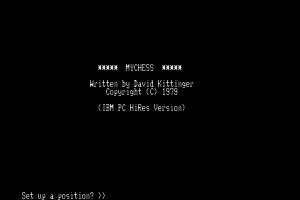
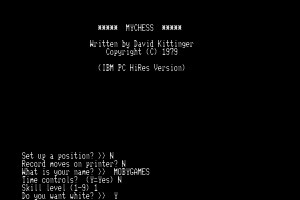
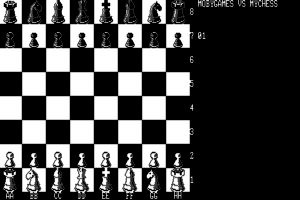
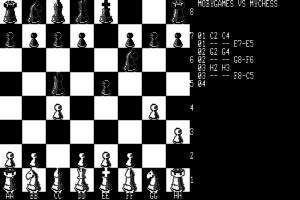
 22 KB
22 KB